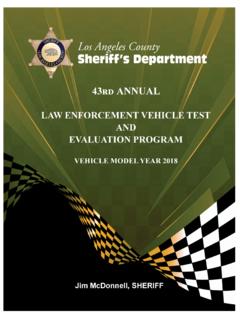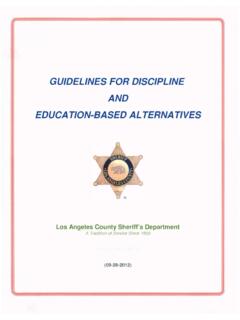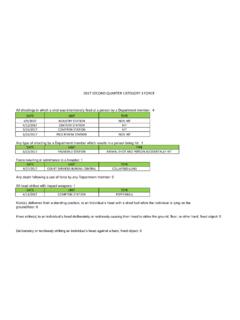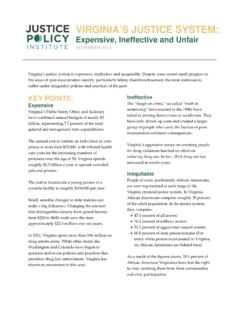Transcription of 43RD ANNUAL LAW ENFORCEMENT …
1 1 43rd ANNUAL LAW ENFORCEMENT MOTORCYCLE TEST AND evaluation PROGRAM MOTORCYCLE MODEL YEAR 2018 Jim McDonnell, SHERIFF 2 TABLE OF CONTENTS 3 4 evaluation 6 Motorcycle 12 Basic Motorcycle 18 32 Lap High Speed Vehicle 21 City Course .. 27 Brake 33 Ergonomics 37 Acceleration 53 Fuel Efficiency 55 Heat 56 Communication 60 3 INTRODUCTION The Los Angeles County Sheriff s Department first implemented its police vehicle testing program in 1974, and motorcycle testing in 2008. Since that time, our Department has become nationally recognized as a major source of information relative to police vehicles and their use. This year s motorcycle evaluation was conducted October 10th 13th, 2017 by the Los Angeles County Sheriff s Department. All major manufacturers of police motorcycles were invited to participate. BMW, Harley Davidson, Honda and Yamaha, submitted motorcycles for evaluation .
2 The motorcycles submitted were: *2018 BMW R 1200 RT-P *2018 Yamaha FJR 1300 *2018 Harley-Davidson FLHTP (Electra) *2018 Harley-Davidson FLHP (Road King) *2016 Honda ST 1300-P All of the motorcycles submitted satisfactorily. The testing process is designed to address the law ENFORCEMENT officer s operational requirements in terms of motor-cycle performance, safety, and comfort. The fleet maintenance interest is addressed by performing an extensive me-chanical evaluation on each motorcycle submitted. Each test is designed and executed to simulate actual field use conditions as closely as possible. Law ENFORCEMENT motorcycle personnel conduct the evaluations on city streets, freeways, and the performance track. This book is not intended as a recommendation for any specific motorcycle contained within, nor is it designed to rank the motorcycles in any order. Our motorcycle testing program is conducted in order to accomplish two prima-ry goals. To provide law ENFORCEMENT agencies with the data necessary to assist those in the motorcycle selection process, and to provide the various motorcycle manufacturers with the input necessary to better meet the needs of law ENFORCEMENT .
3 We recognize the fact that individual agency needs can be influenced by cost, operational considerations and other factors. As such, interpretation of test results is the responsibility of each agency, and should be made based upon that agency s needs. It is our goal to provide law ENFORCEMENT agencies with the information they require to successfully evaluate and select the right motorcycle for their needs. We believe that we have accomplished that goal. 4 ACKNOWLEDGEMENTS The Los Angeles County Sheriff s Department, Fleet Management Bureau would like to thank all those who contributed their time and efforts in making this year s test a success. Motorcycle Test Track Riders Dep. Shawn Bryant LASD Ofc. Mitch Nowlen LAPD Dep. Jeffery Houle LASD Ofc. Roland John LAPD Dep. Marcello Sepulveda LASD Motorcycle Manufactures BMW Police motorcycles Harley Davidson Police motorcycles Huntington Beach Honda Police motorcycles Honda Police motorcycles Yamaha Police motorcycles Support Personnel Max Thomson (Test Director) LASD Reserve Forces Bureau Jason Hausken (Test Manager) LASD Food Services Rochelle Kidd (Vendor Coordinator) LASD Print Shop Stephen Adebanjo (CFMB) LASD Sign Shop Juan Amaya (FSB) LASD Web Development Unit Yolanda Gomez (CFMB) PENSKE Vincent Santiago Guadalupe La Voie (CFMB) PENSKE Robert Yip George Ramirez (CFMB) PENSKE Lupe Granados Gina Spencer (CFMB) Dennis Stanlee (CFMB) Dep.
4 Jeff Tesdahl (EOB) Wynjellyn Ngie (CFMB) Vehicle evaluation Team Ergonomic Drivers Communication Noise Shawn Bryant, LASD Richard Santivong, ECT Supervisor Jeff Houle, LASD Joeseph Nassar, ECT Chunggun Choi, ECT Vehicle Test Sponsors Federal; Signal Setina Manufacturing Whelen Manufactured Ford Motor Co. Police Vehicles General Motors Police Program (Chrysler) FCA USA, LLC We would like to give a special thanks to the Auto Club Speedway staff for helping to make this event possible. 5 ACKNOWLEDGEMENTS (Continued) The Los Angeles County Sheriff s Department Fleet Management Bureau would like to thank the following companies for their participation and continued support of the LASD Vehicle Test vendor expo. 10-8 RETROFIT INC. INDUSTRIAL VAN & TRUCK AIRWAVE COMMUNICATIONS IMPERIAL JOTTO DESK WESTIN PUBLIC SAFETY LINK ENGINEERING CO.
5 TRUCK VAULT PRISONER TRANSPORT SYSTEMS CROSSCO/CODE 3 RACEWAY FORD FEDERAL MOGUL MOTORPARTS RAYBESTOS HUNTINGTON BEACH HONDA TOMAR ELECTRONICS. INC BMW MOTORRAD USA YAMAHA POLICE motorcycles GETAC HARLEY DAVIDSON MOTORCYCLE COMPANY HAVIS/ ASG MARKETING TROY PRODUCTS WEST COAST LIGHTS AND SIRENS WATTCO EQUIPMENT, INC 6 MOTORCYCLE evaluation PROTOCOL 7 32 LAP HIGH-SPEED COURSE TEST RIDER'S SUBJECTIVE evaluation This evaluation is conducted on a high-speed riding course. It is designed to evaluate, identify and elimi-nate the obvious unacceptable motorcycles ( , those motorcycles that are demonstrably unstable or oth-erwise exhibit unsafe characteristics). For this evaluation , four riders are used for each motorcycle. Each rider completes eight laps around our mile test track at the Auto Club Speedway in Fontana, for a total of 32 timed laps.
6 Lap timing is via a GPS based Race Logic Drift Box 02 with a Video VBOX Data logger utilized for secondary lap tim-ing. Both Data logger units are mounted on the motorcycle. The fastest and the slowest lap times are elim-inated, the remaining six lap times are averaged. The average time and speed are recorded next to the rid-er s name. There are four Emergency Vehicle Operations Center (EVOC) motorcycle training instructor riders. Two are from the Los Angeles County Sheriff s Department and two are from Los Angeles Police Department, that share the riding and evaluation of these motorcycles . At the conclusion of the preliminary handling portion of the evaluation , each rider completes a "Rider s Subjective evaluation " form. If the motorcycle is judged unacceptable in this preliminary review, it is rejected and not subjected to further evaluation . CITY COURSE This evaluation is for motorcycles identified by the manufacturer as intended for law ENFORCEMENT use.
7 This evaluation is conducted on a closed mile city street course which closely represents the environ-ment most urban law ENFORCEMENT agencies must contend with. The course has several straight-a-ways and consists of multiple right and left turns and obstacles in the roadway. This is the final track evaluation , and the manufacturers, if they so choose, are allowed to rebuild the motorcycles brake system prior to this portion of the evaluation process. For this evaluation , two riders are used for each motorcycle. Each rider completes two laps around the city course. Lap timing is via a GPS based VBOX Datalogger timing device, mounted on the motorcycle. The combined times of the two laps are recorded next to the rider's name. 8 BASIC MOTORCYCLE PATTERNS Five circle patterns will be used to determine each motorcycle s minimum turning radius. The diameters of the circles will be 20, 19, and 18 feet. The circle pattern will be entered at a speed of 2-3 mph.
8 Once inside the circle, the rider will make three revolutions in one direction, exit the circle and make three more revolu-tions in the opposite direction. The circle pattern will be ridden in first gear. Each motorcycle will be ridden in five different 180 degree U-Turn patterns. The diameters of the U-Turns will be 20, 19, 18, 17, and 16 feet. The U-Turn will be entered at a speed of 2-3 mph in first gear. The rider will fully turn the handlebars and lean the motorcycle as necessary to complete the turn. This is done in both directions. The 30 mph cone weave consists of seven sets of three cones each, alternately offset from a center line at 36 foot intervals. The rider will approach the pattern from a sufficient distance to establish and maintain a speed of 30 mph. Using counter steering, the rider will weave the motorcycle around the seven sets of cones maintaining 30 mph, plus or minus 2 mph. The 30 mph cone weave represents steering or negotiat-ing around debris or other hazards on the roadway.
9 The Short Cone Weave pattern uses eight single cones placed in a straight line at various distances. The cones will be placed at 11, 10 , and 10 foot intervals measured from cone center to cone center. The rider will negotiate the cone weave at about 1-2 mph in first gear, utilizing the rear brake as needed. Lock-to-lock turns will be used to successfully ride the course. This exercise represents typical motorcycle maneuverability used in slow-speed ENFORCEMENT riding. All of the Basic Motorcycle Pattern evaluation protocols will be conducted by all four riders. ACCELERATION PERFORMANCE evaluation This evaluation is designed to measure motorcycle performance and control in terms of acceleration, in-cluding speed and time elapsed at the quarter mile. Although the top speed is not recorded, a minimum speed of 100 mph is generally obtained to satisfy the requirements for high-speed law ENFORCEMENT patrol. Special attention will be paid to overall acceleration, stability, loss of rear wheel traction, and whether or not the front wheel lifts off the ground uncontrollably.
10 Three runs will be made with each motorcycle. The results will be averaged. All of the information gathered during the acceleration evaluation is gathered using a RaceLogic Drift box 02 Datalogger . The Datalogger is a GPS based measuring device. This electronic device measures distance, time and speed. 9 BRAKE evaluation This evaluation procedure measures the braking response and efficiency of the motorcycle. There are three different brake evaluations: A hard braking evaluation , a transitional braking evaluation from a dry to a wet surface, and a transitional braking evaluation from a smooth surface to a sandy surface. Stopping distance is recorded electronically via a GPS based VBOX Datalogger. The hard brake evaluation is conducted by first accelerating the motorcycle to 80 MPH, then decelerating to a stop, maintaining an average deceleration rate of 22 feet per second. This procedure is repeated three additional times. The motorcycle is then immediately accelerated to 60 mph and then stopped as quickly as possible, simulating a panic stop.










